|

by Richard Hoagland
Saturday, August 20, 2005
from
EnterpriseMissionCaptain'sBlog
Website
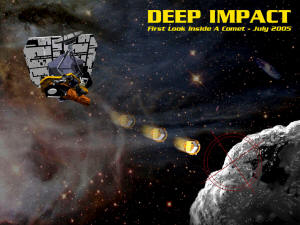
OK, courtesy of
Linda Moulton Howe's latest interview,
we've finally had our first peek at some REAL data from Deep Impact
(or, we're supposed to think we have) ....
What do we now know?
Well, for one thing, we know that major efforts at continued
"misdirection" on the whole Deep Impact issue still abound; from
what Linda was told just a few days ago by Dr. Carey Lisse,
member of the Deep Impact Science Team, she now reports that:
"... the Deep Impact mothership was
not pointing exactly the right way to get the best spectral
results when the impactor slammed into Tempel I [emphasis
added]."
Now, that's original ....
For, according to Keyur Patel, JPL Deep Impact Deputy
Project Manager, speaking before the world's press in a packed
JPL auditorium just minutes after the climax of the Project in the
wee hours of July 4th:
"... The Impactor went and hit the
Comet [Tempel 1] in a specific spot. The Fly-By's job was to
image that spot. And, between the two of them ... the
coordination ... we had the spot nailed ... to less than fifty
meters off!
"So, the Fly-By [spacecraft] imaged the spot within fifty meters
of where the Impactor hit ... that's just amazing [emphasis
added] ...."
To understand the full implications of
this description, and why it totally contradicts what Linda's now
been told,
-
you have to know that all the
science instruments aboard the Fly-By spacecraft - including
the critical spectrometer - were boresighted (aimed) at that
same ~50-meter spot Patel described.
-
that "fifty meters" is about
half the width of a football field ... in this case, as seen
from across almost twice the width of the United States
(from ~5000 miles away)!
So, Patel's official remarks that night
- regarding Deep Impact's superb aiming accuracy - were, if
anything, a major understatement!
In addition, immediately following Patel's glowing assessment of his
JPL Deep Impact Team's technical performance, Principal
Investigator of the Science Team, Dr. Michael A'Hearn
(far right - below), added his own enthusiastic statements.
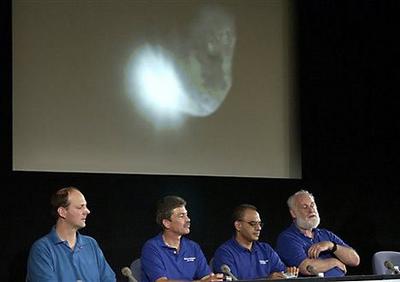
Said A'Hearn:
"... the Impactor was perfect. The
Fly-By instruments also worked beautifully: we got tremendous
spectra ... new spectral features ... really strong spectral
features ... great thermal spectra [emphasis added] ...."
However, now ... just six weeks later
... after directly contradicting both the Deputy Project Manager and
his own Team Leader - by claiming the Fly-By spacecraft at Impact
"was not pointing exactly the right way ...", Linda then reports Dr.
Lisse as telling her:
"... But back toward Earth, the
largest infrared telescope ever launched into space was watching
the Deep Impactor collide with the comet. The Spitzer Space
Telescope was monitoring in a 5 to 40 micron wavelength range,
which was more sensitive than Deep Impact's 1 to 5 micron
wavelength range.
Deep Impact was so close, it could
only see a part of the comet's coma, which is the fuzzy haze of
glowing dust that surrounds the comet's hard nucleus. Spitzer
could see the whole coma, the hot gases and the ejecta rushing
out from the explosion for hours and days afterward [emphasis
added] ...."
Lisse's exact words were:
"Of all the data I've seen [on the
Deep Impact event], Spitzer is one of the most gorgeous data
sets. I think we've got the first good handle on excavating a
comet and finding the dinosaur bones of the solar system's
formation ...."
OK, let's use a little common sense.
Here we have two spacecraft - each armed with a "telescope" and a
"spectrometer." One telescope (the one called "Spitzer") is about
three times wider (~10 times larger in area) than the other, the
smaller telescope located on the Deep Impact Fly-By spacecraft.
But, Deep Impact was located only 5000 miles from the location of
the Comet at Impact. The larger Spitzer instrument, though about ten
times more sensitive (because its mirror has about ten times the
area of Deep Impact's), was located MUCH farther away from the point
of Impact: in fact, in a large Earth orbit ... about 83 MILLION
miles away!
It doesn't take a professional astronomer or optics expert to
instantly know that the closer instrument to Tempel 1 - the one on
Deep Impact - would have been VASTLY more sensitive than the other
telescope (Spitzer), located millions of miles away. The actual
difference in sensitivity (if anyone wants to work through all the
numbers - factoring in the respective spacecraft distances ... the
relative size of the two telescopes on-board, etc., etc.), is that
Deep Impact's spectrometer that night was about 30 MILLION times
more sensitive than Spitzer's equivalent instruments orbiting the
very distant Earth!
"Thirty million times" is a HUGE advantage in this game ... in terms
of both the ability to see faint spectral features (sensitivity to
low percentages of key materials, anyone ...?), and to record short
time-scale events. Like ... what really came gushing out of Tempel 1
in those first few critical seconds after Impact!
So, the flat assertion
in Linda's story, that,
"... the Spitzer Space Telescope was
monitoring in a 5 to 40 micron wavelength range, which was more
sensitive [to the effects of the Impact] than Deep Impact's 1 to
5 micron wavelength range ...."
Is bunk!!
The immediate result of this deft misdirection by Dr. Lisse is
evident in his "major scientific conclusions" from the Deep
Impact Experiment itself.
That,
"the very first data showed hot
water. At least 50% of Comet Tempel I is water ice [emphasis
added] ...."
Oh ... really?
By deliberately ignoring Deep Impact's close-in data ("the
spectrometer was pointed in the wrong direction ..."), and focusing
instead on the millions-of-miles-distant Spitzer observations ...
what Lisse was doing was averaging the effect of Deep Impact's
violent collision - and the resulting materials which
immediately gushed out - with the literally weeks of preceding "outgassing"
of volatiles from Tempel 1, and their enormous expansion into the
surrounding cloud ("coma") around the tiny ~5-mile nucleus ... a
volume of literally millions of cubic miles.
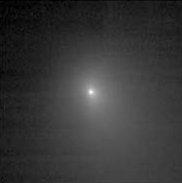
The result was a dramatic, artificial
skewing of the spectroscopic water data from the Spitzer instrument
... by averaging all the previous water which had accumulated in
that extended "coma" (cloud) ... which would have inevitably made it
look like far more water initially erupted from Tempel 1 on Impact -
that "50%" that Linda quoted - than actually occurred!
What the Deep Impact Team said they wanted to observe before
we got there - the overriding reason they sent a $333 million-dollar
Fly-By spacecraft to observe this Event close-up - was to see (and
record) the localized eruption of the pristine, interior materials
from the Direct Impact site!
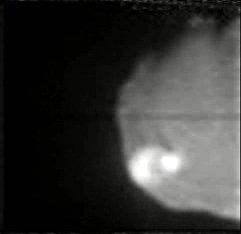
What Lisse was now reporting was
a travesty on those original scientific intentions - a deliberate
averaging of the water in the entire cometary coma ... as seen from
a spacecraft 83 million miles distant ... at the critical moment.
Corroboration of this apparent effort to "inflate the amount of
water" coming out of Tempel 1 at Impact comes from an impeccable
scientific source: data from the independent "SWAS
satellite" (below) - reported here (and elsewhere) almost
immediately after Impact.
SWAS, you may remember, was another spacecraft (operated by another
NASA scientific team, from the Harvard-Smithsonian Center
for Astrophysics) that was also observing Tempel 1 from Earth
orbit - analyzing the "submillimeter" radio emissions from the water
released on Impact.
Like Spitzer, because it was so
far away, the SWAS submillimeter wave antenna was "seeing"
the entire comet's coma - that vast cloud of gas and dust (including
water vapor) which had been slowly outgassing from Tempel 1 in the
weeks before Deep Impact arrived ....
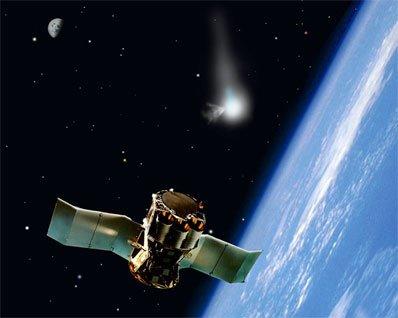
But, in direct contradiction to
Lisse's Spitzer report - this is what
the Harvard-Smithsonian SWAS Team published on
July 8th; what they "saw" at Impact:
"It's pretty clear that this event
did not produce a gusher," said SWAS principal investigator
Gary Melnick of the Harvard-Smithsonian Center for
Astrophysics (CfA).
"The more optimistic predictions for
water output from the impact haven't materialized, at least not
yet [emphasis added]."
The SWAS team measured about 730 pounds
of water per second being released from Tempel 1 before Impact.
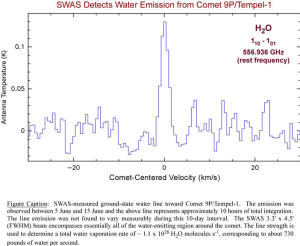
And, about
550 pounds per second after ...
indicating that the collision actually slowed the water
release rate!
Remember, these observations were also averaging the previous
material with "the new stuff": the water vaporized directly by the
Impact ... together with the H2O previously present in
the coma. If that latter number went down - which it did, as SWAS
observed the Comet - it could only mean one thing:
That - in striking contrast to what Linda was told by Lisse -
the material exploding out of Tempel 1 after it was struck, was
essentially ... BONE DRY!!
Only that type of event could explain the SWAS team's unequivocal
evidence of a reduction in average water in the coma - both in
absolute terms, and as a percentage of total material ... after the
Impactor hit the Comet!
Not exactly a "stunning confirmation" of Lisse's (obviously) biased
reporting of the Spitzer water observations of Tempel 1 ....
Now, if we only had access to the Deep Impact Fly-By spacecraft data
of the plume itself ... ALL these (apparent?) contradictions could
be easily resolved ... Oops, I forgot: according to Dr. Lisse,
Deep Impact was pointing the wrong way at that critical moment!
How ... "unfortunate."
Despite this last-minute, obviously attempted "save" of the "dirty
snowball model,"
what Lisse told Linda next is REALLY
fascinating: because ... it supports the exact opposite
of that "standard" NASA cometary model ....
Dr. Lisse:
"... we've concluded so far that we
see every major rock-forming element that makes up the Earth in
this Comet Tempel I [emphasis added]."
Well ... not every element ....
"Except for iron ... the iron is
hiding.
"We're trying to figure that out: is it just not easy to see in
the infrared? Or, is the iron hiding in an iron oxide or iron
sulfide, pyrite or rust [emphasis added]?"
Of course, this is where the Deep Impact
Fly-By spectra would be MOST useful.
In those first few seconds, as the plume of super-heated hot gases
and plasma rushed out of the hole created in Tempel 1 by the 6.3
mile-per-second Impact, even iron bound up in some oxide should have
been split into raw elements - the iron revealing itself through
primary iron emission lines ... as the material erupting would have
been (for those first few seconds) ... hotter than the surface of
the Sun!
And, of course, if the iron was hiding as "iron oxides" (as Lisse
rather desperately suggested ...) - these are seen all the time (as
solid minerals) in on-going IR observations of the planets: the
current Mars Odyssey, Mars Express and Mars Rover spectral
observations are seeing (and identifying) all sorts of iron
compounds in the Martian rocks and dust these days ....
So, the fact that Dr. Lisse can't seem to find ANY iron in
his,
"... 5 to 40 micron wavelength"
Spitzer spectra of Comet Tempel 1, even after such a
violent, high-temperature impact, must be trying very hard to
tell us "something" .... [Or ... is it Dr. Lisse who's trying to
do "the telling" - between (sorry ...) his missing "spectral
lines?"]
Bottom line: this striking "lack of
iron" in Tempel 1 is impossible ... if the "standard" comet model is
correct! Which, of course, is why Dr. Lisse was so obviously
concerned ....
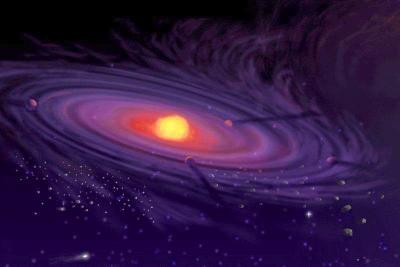
In the classic processes envisioned for
the formation of the solar system (above), iron is thought to have
been amply represented (and mixed into the so-called "solar nebula")
- along with all the other elemental and chemical constituents which
eventually went on to form the planets, via a process called
"accretion."
This iron is thought to have formed originally via "nucleosynthesis"
in massive stars, and then to have spread across the interstellar
night via their eventual catastrophic explosions - as brilliant
"supernovae."
In this standard "element synthesis
model," it is these massive exploding stars which ultimately "seed"
interstellar clouds of collapsing gas and dust ("accreting solar
systems" ...) with all the elements heavier than hydrogen and helium
needed to make planets ....
Including iron.
If comets in general - and Tempel 1 in particular - are truly
representative of the "pristine, materials" which in a distant time
collapsed to form our solar system's worlds ... then iron should
be readily apparent in the cloud of material which erupted from Deep
Impact.
If it is NOT .... then, just perhaps, comets - and certainly Tempel
1 - are NOT "pristine remnants of that ancient forming solar
system" after all ....
And ... wouldn't THAT be interesting?
The one known process which could deplete Tempel 1 of essentially
ALL its iron, of course, would be if it is, actually, a surviving
fragment of highly differentiated, former planetary crust ....
Which was blown into deep space with the catastrophic explosion of
Planet V - EXACTLY as Tom Van Flandern (from
his celestial mechanics calculations) and I (from the "Mars
Tidal Model") have been saying for some time!!
In this scenario, billions of years ago the "missing iron" in Tempel
1 - except for trace amounts - sank to the center of its parent
planet during its formation, to form a "nickel-iron core."
When Planet V exploded billions
of years later, these "highly-differentiated outer fragments"
(severely depleted in primordial iron) were ejected first ... so we
are far more likely to see still remaining fragments of this ancient
planetary crust ... as opposed to any remnants of the former
planet's iron core (which would have vaporized anyway, as the
internal pressures were suddenly released) ....
From the data that Lisse has provided us, Tempel 1 is
increasingly looking like one of those ... a surviving crustal
fragment of this exploded planet!
This also easily now explains Lisse's other provocative statement:
" ... we see every major
rock-forming element that makes up the Earth in this Comet
Tempel I [emphasis added]."
Of course he does ... because, based on
this evidence, Comet Tempel 1 was once a part of the
highly-differentiated surface of a planet just like Earth ... called
"Planet V!"
But, the coup de grâce for the "primordial" Tempel 1 comet model
came with Lisse's most astonishing revelation to Ms. Howe.
That:
"... and we have also found evidence
for carbonate in Deep Impact ....
"Carbonate is interesting in that it's like calcium carbonate,
limestone, that you find on the Earth. We do not think there is
any indication for life, before I go down that road, or [that]
there is any intimation of that. Carbonates are interesting in
that hints of them were seen once in Comet Halley. They are
controversial because folks will be surprised to see them.
Usually you need a liquid water environment to form them. You
have carbon dioxide. You have water. And you have silicates,
then you can form carbonate.
"What's confusing is that comets, as far as we know, were formed
at about 30 to 40 degrees Kelvin above absolute zero. Very cold!
Think 'ice ball' - and very little chemistry can happen to them.
"On the other hand, you have 5 billion years to make stuff ....
"So even if you are making things extremely slowly ... it's
possible you can make carbonates in a solid state.
"Now, it's also possible that our chemistry folks will tell us,
that what you did was form the carbonates in the primordial
cloud that condensed into the solar system. That you did your
[wet] chemistry before you condensed your comet at 30 to 40
degrees Kelvin. So this might be another clue as to the recipe
to how things came together [emphasis added] ...."
Or ... not!
Remember that little scientific cliché called Occam's Razor -
"the simplest explanation for a given phenomenon is usually the one
that turns out to be correct" ...? This is the time to bring it back
- with a vengeance.
The simplest explanation for the discovery of calcium carbonate in
Tempel 1 is that it formed in those same oceans that created the
sedimentary "beach sand" (silicon dioxide) that the Gemini North
Observatory Team independently reported at Deep Impact several
weeks ago!
According to
the July 7th official Gemini North press
release:
"'... The properties of the
mid-infrared light [5 to 28 microns] were completely transformed
after impact,' said David Harker of the University of San
Diego, co-investigator for the research team. 'In addition to
brightening by a factor of about 4, the characteristics of the
mid-infrared light was like a chameleon and within five minutes
of the collision it looked like an entirely new object.'
Harker's research partner Chick
Woodward of the University of Minnesota speculated further,
'We are possibly seeing crystalline silicates which might even
be similar to the beach sand here in Hawaii! This data will keep
us busy trying to figure out the size and composition of these
grains to better understand the similarities and differences
between the material contained within comets and other bodies in
the solar system [emphasis added] ..."
What could be simpler: two compounds
discovered in Tempel 1, via two independent teams - "limestone" and
"beach sand!" - each specifically requiring liquid water for their
formation ....
Simple, of course ... if you then realize that Tempel 1 was once
part of a major planet - which obviously had major oceans!
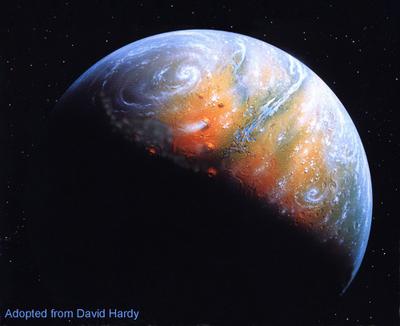
Lisse had other fascinating
things to say
in his interview with Linda -
including, dropping hints about some unusual "hydrocarbon compounds"
Spitzer had observed in Tempel 1 ... such as "PAHs" (polycyclic
aromatic hydrocarbons) . He also went into more detail on what
Spitzer had NOT seen ....
It's the "not" which, for the moment, is of far more significance.
For, in addition to NOT detecting iron, Lisse admitted that:
"What's [also] missing is ammonia.
The amino in the word 'amino acid' is ammonia. But it does not
mean ammonia is not there (on Comet Tempel I); ammonia has been
terribly difficult to detect very well in comets. We have seen
hints of it. We're pretty sure it is in comets. But it is hard
to find [emphasis added] ...."
Perhaps ... because it really isn't
there!?
Looking for ammonia in comets, again, is totally premised on
the idea that comets are "primordial."
The nitrogen (N2) found in Earth's current atmosphere,
the same gas found in Mars' atmosphere, and the tiny amount even
present in Venus' atmosphere ... is all thought by planetary
scientists to originally come from the breakdown of primordial
ammonia (NH3), formed in the infant solar nebula and
accreted into planets.
And, since comets have to be (according
to most of these same folks) the untouched pre-planetary products of
that same nebular accretion process (and thus "primordial") - these
same planetary science folks (according to Dr. Lisse) have spent a
LOT of time over the history of comet observations looking for
precisely such "cometary ammonia".
Without luck.
Of course, if the nitrogen observed in Tempel 1 by Spitzer - bound
with elements other than just hydrogen, forming more interesting
compounds like "hydrogen cyanide" (HCN) or "methyl cyanide" (C2H3N1)
- is actually derived from a secondary planetary atmosphere ... from
a source of free nitrogen like our own, on a highly evolved world
that one day catastrophically exploded ... then the so-far fruitless
search for the "missing cometary ammonia" also becomes just another
dead end in the "comets are primordial" scenario.
But, it is Lisse's physical description of Tempel 1, based on the
highest resolution imagery Deep Impact acquired (which we have not
yet seen, of course), which puts it all together:
"We've gotten the up-close images
that will be released soon [now ... that's interesting ....
Didn't someone on the Mission just a few weeks ago claim these
close-up images were "hopelessly blurred!?" ...] - and there's
all kinds of interesting geology on this body.
"It's got at least three different terrains that look very
different. It's got young and old craters (we think it's been
cratered for ten million to a hundred million years). It's got
all kinds of structure on it.
"... Tempel I is nothing like just an ice ball that's been put
together 5 billion years ago, and [is still] slowly boiling off;
it's got a lot of things going on [emphasis added] ...."
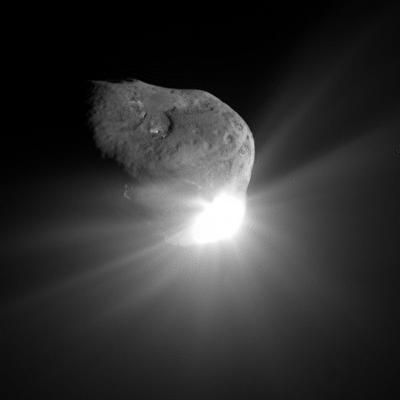
In other words .... far from being the
simple "dirty snowball" that so many had expected, Tempel 1 - even
from this glimpse at partial data - has turned out to be a
bewilderingly complex object, both chemically and
physically ... with astonishing geological diversity packed into
a volume of only a few miles ....
Not exactly an historical description of your "average mainstream
comet."
But, exactly how one would describe a collection of "ancient,
layered rocks" ... evolved on the surface of geologically diverse
world like our own planet, and then literally smashed together in an
almost inconceivable planetary explosion ... which ejected this
assembled fragment deep into the outer solar system ... until the
Deep Impact spacecraft found it.
Voila: an almost "textbook example" of Van Flandern's
"Exploding Planet Hypothesis!"
We must hand it to Linda Moulton Howe for securing even this
limited degree of information regarding this increasingly
mysterious NASA Comet Mission. It should be obvious by now
that Comet Tempel 1 is anything but what most of the NASA
investigators involved in trying to understand Deep Impact's data
must have expected ... when they began their search "for the origins
of comets" on this Mission over seven years ago ....
Perhaps that explains their scientific shock, reflected - as opposed
to ALL previous NASA planetary missions - in their obvious
reluctance to release their increasingly amazing data from Deep
Impact ... even after several weeks.
And - their apparent willingness to "go along" with even the most
absurd of "cover stories" re this Mission - in hopes perhaps that
some might buy them precious time, to truly understand what a few
scientists must now be realizing as "the almost inconceivable":
hard, scientific evidence of an actual exploded world!
"Cover stories" that persist and are still growing, even though
these multiple excuses re Deep Impact - put forth in these last
weeks by a variety of individuals - are now quite blatantly and
ridiculously contradicting one another ....
Meanwhile, our own NASA "inside sources" are working quietly
to gather additional information for us on this increasingly bizarre
Mission ... to help us understand this increasingly mysterious - but
crucial - "miniature world" called "Tempel 1."
Some new data has already been provided - and correlates well with
what Dr. Lisse has now (inadvertently?) disclosed. But much
work still remains before we can publish our own Model - on what
we believe NASA's really found ... and doesn't quite know how to
tell us ....
Stay tuned.
|









